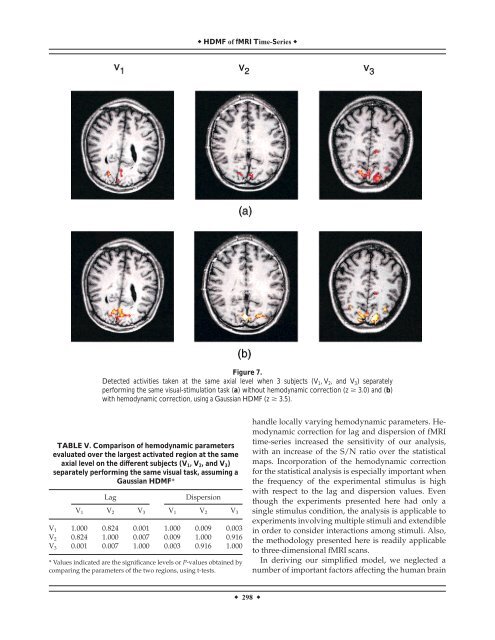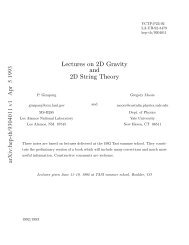Modeling hemodynamic response for analysis of functional MRI time ...
Modeling hemodynamic response for analysis of functional MRI time ...
Modeling hemodynamic response for analysis of functional MRI time ...
Create successful ePaper yourself
Turn your PDF publications into a flip-book with our unique Google optimized e-Paper software.
HDMF <strong>of</strong> f<strong>MRI</strong> Time-Series <br />
Figure 7.<br />
Detected activities taken at the same axial level when 3 subjects (V 1 ,V 2 , and V 3 ) separately<br />
per<strong>for</strong>ming the same visual-stimulation task (a) without <strong>hemodynamic</strong> correction (z 3.0) and (b)<br />
with <strong>hemodynamic</strong> correction, using a Gaussian HDMF (z 3.5).<br />
TABLE V. Comparison <strong>of</strong> <strong>hemodynamic</strong> parameters<br />
evaluated over the largest activated region at the same<br />
axial level on the different subjects (V 1 ,V 2 , and V 3 )<br />
separately per<strong>for</strong>ming the same visual task, assuming a<br />
Gaussian HDMF*<br />
Lag<br />
Dispersion<br />
V 1 V 2 V 3 V 1 V 2 V 3<br />
V 1 1.000 0.824 0.001 1.000 0.009 0.003<br />
V 2 0.824 1.000 0.007 0.009 1.000 0.916<br />
V 3 0.001 0.007 1.000 0.003 0.916 1.000<br />
* Values indicated are the significance levels or P-values obtained by<br />
comparing the parameters <strong>of</strong> the two regions, using t-tests.<br />
handle locally varying <strong>hemodynamic</strong> parameters. Hemodynamic<br />
correction <strong>for</strong> lag and dispersion <strong>of</strong> f<strong>MRI</strong><br />
<strong>time</strong>-series increased the sensitivity <strong>of</strong> our <strong>analysis</strong>,<br />
with an increase <strong>of</strong> the S/N ratio over the statistical<br />
maps. Incorporation <strong>of</strong> the <strong>hemodynamic</strong> correction<br />
<strong>for</strong> the statistical <strong>analysis</strong> is especially important when<br />
the frequency <strong>of</strong> the experimental stimulus is high<br />
with respect to the lag and dispersion values. Even<br />
though the experiments presented here had only a<br />
single stimulus condition, the <strong>analysis</strong> is applicable to<br />
experiments involving multiple stimuli and extendible<br />
in order to consider interactions among stimuli. Also,<br />
the methodology presented here is readily applicable<br />
to three-dimensional f<strong>MRI</strong> scans.<br />
In deriving our simplified model, we neglected a<br />
number <strong>of</strong> important factors affecting the human brain<br />
298
















